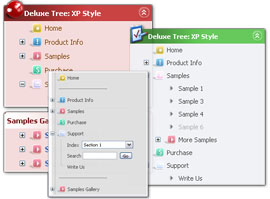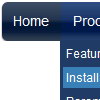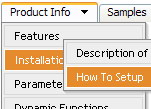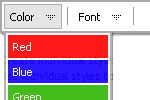Recent Questions
Q: I haven’t had any problems using the drop line menu, until now when I had to make some changes. After adding some sub-menu items on two of the drop line menu buttons, those menu’s drop down upwards, instead of downwards like the rest. I tried deleting them and remaking them, but then the menu appeared to have no image behind it, only a colour. So I duplicated a working menu item, and then modified it to be what I wanted – and it still drop down upwards!
A: Please check the following drop line menu parameter:
var subMenuVAlign="top";
Q: Where can I give the body of the javascript method which I use in cool dhtml menu?
A: You can define functions after menuItems, before you call dm_init();function.
var menuItems = [
["text", "javascript:your_function(...)", ...]
];
Where your_function(...):
function your_function(...)
{
.....
}
Q: What i am doing is a horizontal menu with submenus opening down vertically. The main menu and sub menu has a background image. These are rather large for a menu and when the sub menu expands i want it to stay below the main menu and not go upwards to cover the main menu when the browser window is too small.
A: Yes, they will stay forcibly below the main menu.
You can use Smart Scrollable Feature. In that case sub menus won't cover
the main menu items. You can see an example here
http://deluxe-menu.com/scrollable-submenus-sample.html
You may specify the exact height for submenus, for example:
var smHeight="500px";
Use the following parameters to set the direction for submenus:
var subMenuAlign="left";
var subMenuVAlign="top";
For more info see:
http://deluxe-menu.com/ways-showing-submenus-sample.htmlQ: Also once you click a link and go to a new page, how do you get the java choice menu tab for that new page to stay the highlighted one?
A: Deluxe Tabs doesn't support API functions which can return theselected tab aslo.
You can set "bselectedItem" and " var bselectedSmItem" parametersbased on your link before you call your data file.
For example, move " var bselectedItem" and " var bselectedSmItem" parametersfrom your data file to your code.
<TD vAlign=top align=left>
/* Select Tab */
<script type="text/javascript" language="JavaScript1.2">
var bselectedItem=<?php echo $seltabs; ?>;
var bselectedSmItem=<?php echo $selsmtabs; ?>;
</script>
<SCRIPT src="data.js" type=text/javascript></SCRIPT>
</TD>
You should define seltabs and selsmtabs using server side script.
You can also set it on every page before you call data.js file, forexample:
<TD vAlign=top align=left>
/* Select Tab */
<script type="text/javascript" language="JavaScript1.2">
var bselectedItem=4;
var bselectedSmItem=3;
</script>
<SCRIPT src="data.js" type=text/javascript></SCRIPT>
</TD>










